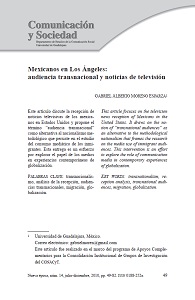Mexicanos en Los Ángeles: audiencia transnacional y noticias de televisión
DOI:
https://doi.org/10.32870/cys.v0i14.1248Palabras clave:
transnacionalismo, análisis de la recepción, audiencias transnacionales, migración, globalizaciónResumen
Este artículo discute la recepción de noticias televisivas de los mexicanos en Estados Unidos y propone el término "audiencia transnacional" como alternativa al nacionalismo metodológico que persiste en el estudio del consumo mediático de los inmigrantes. Esta entrega es un esfuerzo por explorar el papel de los medios en experiencias contemporáneas de globalización.Descargas
Citas
ACS–American Community Survey (2005–2007). US Census Bureau. Recuperado dehttp://factfinder.census.gov/servlet/DatasetMainPageServlet?_program=ACS&_submenuId=datasets_2&_lang=en
Ahmed, S. (1999). Home and away: narratives of migration and estrangement. International Journal of Cultural Studies, 2, 329–347.
Ahmed, S. (2003). Uprootings/regroundings: questions of home and migration. Oxford: Berg.
Alasuutari, P. (Ed.). (1999). Rethinking the media audience. Londres: Sage.
Álvarez, R. (1994). Changing ideology in a transnational market: chile and chileros in Mexico and the US.Human Organization, 53, 255–262.
Anderson, B. (1991). Imagined communities: refections on the origin and spread of nationalism. Londres: Verso.
Ang, I. (1991). Desperately seeking the audience. Londres: Routledge.
Appadurai, A. (1996). Modernity at large: cultural dimensions of globalization. Minneapolis, Londres: University of Minnesota Press.
Appadurai, A. (2001). Grassroots globalization and the research imagination. En A. Appadurai (Ed.),Globalization. Duke University Press.
Arendt, H. (1998 [1958]). The human condition. Chicago, Londres: University of Chicago Press.
Basch, L. G., Schiller, N. G. & Szanton, C. (1994). Nations unbound: transnational projects, postcolonial predicaments, and deterritorialized nation–states. Basel, Inglaterra: Gordon and Breach.
Bhabha, H. K. (1994). The location of culture. Londres: Routledge.
Bird, E. (2009). Not dead yet? Some thoughts on the future of qualitative audience studies. Transforming Audiences, 2. Londres.
Bogardus, E. S. (1923). Essentials of americanization. Los Ángeles: J.R. Miller.
Brah, A. (1996). Cartographies of diaspora: contesting identities. Londres: Routledge.
Brunsdon, C. (1981). "Crossroads": Notes on Soap Opera. Screen, 22, 32–37.
Bryce, J. (1987). Family time and tv use. En Thomas, L. (Ed.), Natural audiences. Norwood, NJ: Ablex.
Canovan, M. (1994). Politics as culture: Hannah Arendt and the public realm. En L. P. Hinchman (Ed.), Hannah Arendt: critical essays. Albany, Nueva York: Suny Press.
Castells, M. (2004). The power of identity. Malden: Blackwell.
Castles, S. & Miller, M. J. (2003). The age of migration. Basingstoke: Palgrave Macmillan.
Clifford, J. (1994). Diasporas. Cultural Anthropology, 9, 302–338.
Cohen, R. (1997). Global diasporas: an introduction. Seattle: University of Washington Press.
Constantakis, P. E. (1993). Spanish–language television and the 1988 presidential elections: a case study of the "dual identity" of ethnic minority media. Austin. Texas: The University of Texas at Austin.
Consulado (2009). Acerca del Consulado. Los Ángeles, Secretaría de Relaciones Exteriores. Recuperado el 30 de octubre de 2009 de http://www.sre.gob.mx/losangeles/
Corner, J. (1995). Television form and public address. Londres: Edward Arnold
Cunningham, S. (2004) Popular media as public 'sphericules' for diasporic communities. En Allen, R. & Hill, A. (Eds.) The Television Studies Reader. Londres: Routledge
Dayan, D. & Katz, E. (1992). Media events: the live broadcasting of history. Cambridge, Ma; Londres: Harvard University Press
Faist, T. (1999). Transnationalization in international migrations for the study of citizenship and culture. Working papers series, transnational communities programme. Oxford University. Recuperado el 25 de febrero de 2007 de http://www.transcomm.ox.ac.uk/working%20papers/faist.pdf
Fiske, J. (1989). Understanding popular culture. Londres: Unwin Hy–man
Fiske, J. (1994). Media matters: everyday culture and political change. Minneapolis: University of Minnesota Press
Flaccus, G. (2006). Spanish–language media play key role in promoting pro–immigrant rallies in U.S., Associated Press Newswires, Los Ángeles. Recuperado el 29 de marzo de 2006 de base de datos Factiva.com
Foxnews.com (2007). Schwarzenegger to immigrants: avoid spanish–language media. San Francisco. Recuperado el 21 de mayo de 2008 dehttp://www.foxnews.com/printer_friendly_story/0,3566,282833,00.html
Fraser, N. (2007). Transnationalizing the public sphere: on the legitimacy and efficacy of public opinion in a postWestphalian world. En S. Benhabib, I. S. D. P. (Ed.), Identities, affliations and allegiances. Cambridge: Cambridge University Press.
García–Canclini, N. (1995). Hybrid cultures: strategies for entering and leaving modernity. Minneapolis: University of Minnesota Press.
Gauntlett, D. & Hill, A. (1999). TV living: television, culture, and everyday life. Nueva York: Routledge.
GCIM–Commission on International Migration (2005). Migration in an interconnected world: new directions for action. Recuperado el 26 de enero de 2099 de http://www.gcim.org/attachements/gcim–complete–report–2005.pdf
Georgiou, M. & Silverstone, R. (2007). Diasporas and contra–fows beyond nation–centrism. En Thussu, D. K. (Ed.), Media on the move: global fow and contra–fow. Londres: Routledge.
Giddens, A. (1984). The constitution of society: outline of the theory of structuration. Cambridge: Polity Press.
Giddens, A. (1990). The consequences of modernity. Stanford, CA: Stanford University Press.
Giddens, A. (1991). Modernity and self–identity: self and society in the late modern age. Cambridge: Polity Press Basil Blackwell.
Giddens, A. (1999). Runaway world: how globalisation is reshaping our lives. Londres: Profile.
Gillespie, M. (1995). Television, ethnicity and cultural change. Londres: Routledge.
Gillespie, M. (2002). Dynamics of diasporas: south asian media and transnational cultural politics. En G. Tufte (Ed.), Global Encounters: media and cultural transformation. Luton: University of Luton Press.
González, C. (1999). Fostering identities: Mexico's relations with its diaspora. The Journal of American History, 86, 545–567.
Gunter, B. & Svennvig, M. (1987). Behind and in front of the screen: television's involvement with family life.Londres: Libbey.
Hall, S. (2001 [1980]). Encoding/Decoding. En Kellner, G. D. M. A. D. M. (Ed.), Media and cultural studies: keyworks. Malden, Ma: Blackwell Publishers.
Handlin, O. (1973 [1951]). The uprooted: the epic story of the great migrations that made the american people.Boston: Little, Brown and Company.
Hannerz, U. (1996). Transnational connections: culture, people, places. Londres, Nueva York: Routledge.
Harvey, D. (1989). The condition of postmodernity: an enquiry into the origins of cultural change. Oxford: Basil Blackwell.
Held, D., Mcgrew, A., Goldblatt, D. & Perraton, J. (1999). Global transformations: politics, economics and culture. Oxford: Polity.
Hill, A. (2007). Restyling factual tv: audiences and news, documentary and reality genres. Londres: Routledge.
Hirsch, S. (2003). A courtship after marriage: sexuality and love in Mexican transnational families. Los Angeles: University of California Press.
Hobson, D. (1978). Housewives: isolation as oppression. En CCCS, W. S. S. G. (Ed.), Women take issue: aspects of women's subordination. Londres: Hutchinson.
Hobson, D. (1980). Housewives and the mass media. En S. Hall, D. H., Andrew & P. Willis (Eds.), Culture, media, language: working papers in cultural studies 1972–79. Londres: Hutchinson.
Hobson, D. (1982). Crossroads: the drama of a soap opera. Londres: Methuen.
Huntington P., S. (2004). The hispanic challenge. Foreign Policy, 30–45.
Jenkins, H. (1992). Textual poachers: television fans & participatory culture. Nueva York: Routledge.
Jenkins, H. (2006). Convergence culture: where old and new media collide. Nueva York, Londres: University Press.
Jensen, K. B. & Rosengren, K. E. (1990) Five traditions in search of the audience. European Journal of Communication, 5, 207–238.
Jensen, K. B. (Ed.). (1998). News of the world: world cultures look at television news. Londres, Nueva York: Routledge.
Jensen–Leichter, H., Ahmed, D., Barrios, L., Bryce, J., Larsen, E. & Moe, L. (1985). Family contexts of television. Educational Technology Research and Development, 33, 26–40.
Johnson, M. A. (2000). How ethnic are U.S. ethnic media: the case of latina magazines. Mass Communication and Society, 3, 229–248.
Karim, K. H. (2003). Mapping diasporic mediascapes. En Karim, K. H. (Ed.), The Media of Diaspora. Londres: Routledge.
Kolar–Panov, D. (1997). Video, war and the diasporic imagination. Londres: Routledge.
Leadbeater, C. (2008). We–think. Londres: Profile.
Lemish, D., Liebes, T. & Seidmann, V. (2001). Gendered media meanings and uses. En Bovill, S. L. A. M. (Ed.),Children and their changing media environment: a european comparative study. Mawhaw, nj: L. Erlbaum.
Levitt, P. (2001) Transnational migration: taking stock and future directions. Global Networks, 1, 195–216.
Liebes, T. & Katz, E. (1990). The export of meaning: cross–cultural readings of Dallas. Nueva York, Oxford: Oxford University Press.
Lindlof, T. R. (1987). Natural audiences. Nueva Jersey: Ablex.
Lindlof, T. R. (1988). Media audiences as interpretive communities. En J. Anderson (Ed.), Communication Yearbook 11. Newbury Park, CA: Sage.
Livingstone, S. M. (1998). Making sense of television: the psychology of audience interpretation. Nueva York: Routledge.
Long, N. & Villarreal, M. (1998). Small product, big issues: value contestations and cultural identities in cross–border commodity networks. Development and Change, 29, 725–750.
Lull, J. (1980). The social uses of television. Human Communication Research, 6, 197–209.
Lull, J. (1982). How families select television programmes: a mass observational study. Journal of Broadcasting and Electronic Media, 24, 801–811.
Lull, J. (1990). Inside family viewing: ethnographic research on television's audience, Londres: Routledge.
Mandaville, P. (2002). Reading the state from elsewhere: towards an anthropology of the postnational. Review of International Studies, 28, 199–207.
Martín–Barbero, J. (1993). Communication, culture and hegemony: from the media to mediations. Londres: Sage.
Mayer, V. (2003). Producing dreams, consuming youth: mexican americans and mass media. New Brunswick: Rutgers University Press.
McAnany, E. & Wilkinson, K. T. (1996). Mass media and free trade. Austin: University of Texas Press.
Michelle, C. (2007). Modes of reception: a consolidated analytical framework. The Communication Review, 10, 181–222.
Moores, S. (1993). Interpreting audiences: the ethnography of media consumption. Londres: Sage.
Moreno, G. (2009). Transnational audiences and the reception of television news: a study of mexicans in Los Angeles. Communication Media Research Institute. Londres: University of Westminster.
Moreno, G. (2010). Penar a la audiencia transnacional. Ponencia in–extenso, presentada en el XXI Encuentro Nacional amic 2010, Ciudad de México, 2–4 de junio.
Morley, D. (1980). The Nationwide audience: structure and decoding. Londres: British Film Institute.
Morley, D. (1986) Family television: cultural power and domestic leisure. Londres: Comedia.
Morley, D. & Silverstone, R. (1992). Domestic communication–technologies and meanings. Media, Culture & Society, 12, 31–55.
Morley, D. (2000). Home territories: media, mobility, and identity. Londres: Routledge.
Morley, D. (2006). Unanswered questions in audience research. The Communication Review, 9, 101–121.
Morley, D. & Robins, K. (1995) Spaces of identity: global media, electronic landscapes and cultural boundaries.Londres, Nueva York: Routledge.
Naficy, H. (1993) The making of exile cultures: Iranian television in Los Angeles, Minneapolis, Londres: University of Minnesota Press.
Naficy, H. (2003) Narrowcasting in diaspora: Middle Eastern television in Los Angeles. En Karim, K. H. (Ed.),The Media of Diaspora. Londres: Routledge.
Negus, K. & Román–Velázquez, P. (2000). Globalization and cultural identities. En Gurevitch, J. C. A. M. (Ed.),Mass media and society. Arnold.
Nevaer, L. (2007). For Mexico, "local residence" now includes New York and Los Angeles. Mexico City, New American Media.
Obama, B. (2009) Barack Obama's Inaugural Address. The New York Times. Recuperado el 12 de noviembre dehttp://www.nytimes.com/2009/01/20/us/politics/20text–obama.html?_r=1
Ong, A. (1999). Flexible citizenship: the cultural logics of transnationality. Durham: Duke University Press.
Orozco, G. (1998). Mexican mediations. En Jensen, K. B. (Ed.), News of the world. Nueva York, Londres: Routledge.
PEW (2006). The size and characteristics of the unauthorized migrant population in the U.S. Washington, D.C., Pew Hispanic Center. Recuperado el 7 de marzo de 2007 dehttp://pewhispanic.org/files/reports/61.pdf
Portes, A. (1997). Globalization from below: the rise of transnational communities. Working papers series, transnational communities programme. Oxford University. Recuperado el 4 de febrero de 2009 dehttp://www.transcomm.ox.ac.uk/working%20papers/portes.pdf
Portes, A., Escobar, C. & Arana, R. (2008). Bridging the gap: transnational and ethnic organizations in the political incorporation of immigrants in the United States. Ethnic and Racial Studies, 1–35.
Portes, A. & Rumbaut, R. G. (2006). Immigrant America: a portrait. Berkeley, CA, Londres: University of California Press.
Ríos, D. I., Gaines Jr. & Stanley, O. (1999). Latino media use for cultural maintenance. Journalism & Mass Communication Quarterly, 75, 746–761.
Roberts, B. R., Frank, R. & Lozano–Ascencio, F. (1999). Transnational migrant communities and Mexican migration to the US. Ethnic and Racial Studies, 22, 238–266.
Robertson, R. (1995). Glocalization: time–space and homogeneity–heterogeneity. En M. Featherstone, S. L. A. R. R. (Ed.), Global modernities. Londres: Sage.
Robins, K. (1997). What in the world's going on? En P. D. Gay (Ed.), Production of culture/cultures of production.Sage.
Robins, K. & Aksoy, A. (2001). From spaces of identity to mental spaces: lessons from Turkish–Cypriot cultural experience in Britain. Journal of Ethnic and Migration Studies, 27, 685–711.
Robins, K., & Aksoy, A. (2005). Whoever looks always finds: transnational viewing and knowledge–experience. En J. K. Chalaby (Ed.), Transnational television worldwide: towards a new media order. Londres, Nueva York: I.B. Tauris.
Robins, K. & Aksoy, A. (2006). Thinking through experiences: transnational media and migrants minds. En J. C. A. D. Morley (Ed.), Media and cultural theory. Londres: Routledge.
Rodríguez, A. (1999). Making latino news: race, language, class. Thousand Oaks, Londres, Nueva Delhi: Sage.
Rosaldo, R. (1993). Culture & truth: the remaking of social analysis. Londres: Routledge.
Rouse, R. (1995). Questions of identity: personhood and collectivity in transnational migration to the United States. Critique of Anthropology, 15, 351–380.
Rouse, R. (1996 [1991]). Mexican migration and the social space of postmodernism. En D. G. Gutiérrez, (Ed.),Between two worlds: mexican immigrants in the United States. Wilmington, Del.: Scholarly Resources.
Sabry, T. (2005). Emigration as popular culture. European Journal of Cultural Studies, 8, 5–22.
Sassen, S. (2001). The global city: New York, London, Tokyo. Princeton: Princeton University Press.
Schudson, M. (1995) The power of news. Cambridge: Harvard University Press.
Schudson, M. (2000). The sociology of news production revisited (again). En M. Gurevitch & C. Curran (Eds.),Mass media and society. Londres: Arnold.
Silverstone, R. (1991). From audiences to consumers: the household and the consumption of communication and information technologies. European Journal of Communication, 6, 135–154.
Silverstone, R. (1994). Television and everyday life. Londres, Nueva York: Routledge.
Sinclair, J. (1996b). Mexico, Brazil, and the latin world. En J. Sinclair, E. J., S. Cunningham (Eds.), New patterns in global television: peripheral vision. Nueva York: Oxford University Press.
Sinclair, J. (1999). Latin American television: a global view. Oxford: University Press.
Sinclair, J. (2003). The Hollywood of Latin America: Miami as Regional Center in Television Trade. Television New Media, 3, 211–229.
Sinclair, J. (2004). From Latin Americans to Latinos: Spanish–language television in the United States and its audiences. Revista Fronteiras–estudios midiaticos, VI, 7–20.
Sinclair, J. (2005). International television channels in the latin american audiovisual space. En J. K. Chalaby (Ed.), Transnational television worldwide: towards a new media order. Londres, Nueva York: I.B. Tauris.
Sklair, L. (1998). Transnational practices and the analysis of the global system. Working papers series, transnational communities programme. Londres: Oxford University–School of Economics and Political Science. Recuperado el 4 de febrero de 2009 dehttp://www.transcomm.ox.ac.uk/working%20papers/sklair.pdf.
Smith, A. D. (1999). Myths and memories of the nation. Oxford: University Press.
Smith, M. P. & Guarnizo, L. E. (Eds.). (1998). Transnationalism from below. New Brunswick, Londres: Transaction Publishers.
Smith, M. P. & Bakker, M. (2005). The transnational politics of the Tomato King: meaning and impact. Global Networks, 5, 129–146.
Smith, R. C. (1998). Transnational localities: community, technology and the politics of membership within the context of Mexico and U.S. migration. En M. Guarnizo, P. S. A. L. E. (Ed.), Transnationalism from Below. New Brunswick, Londres: Transaction Publishers.
Sreberny, A. (2000). Media and diasporic consciousness: an exploration among Iranians in London. En S. Cottle (Ed.), Ethnic minorities and the media: changing cultural boundaries. Buckingham, Philadelphia: Open University Press.
Subervi, F. (1986). The mass media and ethnic assimilation and pluralism: a review and research proposal with special focus on hispanics. Communication Research, 13, 71–96.
Subervi, F. & Ríos, D. (2005). Latino identity & situational latinidad. En E. D. Valle, (Ed.), Hispanic marketing and public relations: understanding and targeting america's largest minority. Boca Raton, FL: Poyeen Publishing.
Suro, R. & Escobar, G. (2006). survey of mexicans living in the U.S. on absentee voting in mexican elections. Washington, D.C., Pew Hispanic Center. Recuperado el 29 de septiembre de 2009 dehttp://pewhispanic.org/reports/report.php?ReportID=60
Telemundo (2008). Corporate information. Recuperado el 12 de marzo de 2008 dehttp://tv.telemundo.yahoo.com/corporativo/articulo/29092006/71/corporativo–corporate–information–english.html
Thompson, J. B. (1995). The media and modernity: a social theory of the media. Cambridge, Inglaterra: Polity Press.
Thussu, D. K. (2005). The transnationalization of television: the indian experience. En J. K. Chalaby (Ed.),Transnational television worldwide. Nueva York, Londres: I.B. Tauris.
Thussu, D. K. (2007). Media on the move: global fow and contra–fow. Londres, Nueva York: Routledge.
Tölölyan, K. (1991). The nation state and its others: in lieu of a preface. Diaspora, 1, 3–7.
Tölölyan, K. (1996). Rethinking diaspora(s): stateless power in the transnational moment. Diaspora, 5, 3–36.
Tsagarousianou, R. (2001). A space where one feels at home: media consumption practices among London's South Asian and Greek Cypriot communities. En R. K. A. N. Wood (Ed.), Media and migration: constructions of mobility and difference. Londres, Nueva York: Routledge.
Univisión (2007). Annual report for the fIscal year ended December 31, 2007. New York, Securities and Exchange Commission fling, form 10–K. Recuperado el 12 de abril de 2008 dehttp://www.sec.gov/
Uribe, A. B. (2003). Re–imaginando México con la telenovela. Recepción cultural de telenovelas por inmigrantes mexicanos residentes en Los Ángeles, ca, Tijuana: El Colegio de la Frontera Norte.
Valdivia, A. N. (2003). Salsa as popular culture: ethnic audiences constructing an identity. En A. N. Valdivia (Ed.), A companion to media studies. Malden: Blackwell Publishing.
Vertovec, S. (1999). Conceiving and researching transnationalism. Ethnic and Racial Studies, 22, 447–462.
Williams, R. (2003 [1974]). Television: technology and cultural form. Londres: Routledge.
Wimmer, A. & Glick–Schiller, N. (2002). Methodological nationalism and beyond: nation–state building, migration and the social sciences. Global Networks: A Journal of Transnational Affairs, 2, 301–334.
Yarto, C. & Lozano, J. C. (2004). Televisión, rutinas y vida cotidiana en mujeres de México, Guadalajara y Monterrey [Television, routines and the everyday life of women in Mexico, Guadalajara y Monterrey]. Global media journal en español, Primavera 1–7. Recuperado el 2 de septiembre de 2005 dehttp://gmje.mty.itesm.mx/yarto_lozano.html

Descargas
Publicado
Cómo citar
Número
Sección
Licencia
Los autores/as que publiquen en esta revista aceptan las siguientes condiciones:
De acuerdo con la legislación de derechos de autor, los autores conservan los derechos de autoría y otorgan a Comunicación y Sociedad el derecho de primera comunicación pública de la obra. Comunicación y Sociedad no realiza cargos a los autores por enviar y procesar artículos para su publicación.
Los autores/as pueden realizar otros acuerdos contractuales independientes y adicionales para la distribución no exclusiva de la versión del artículo publicado en Comunicación y Sociedad (por ejemplo incluirlo en un repositorio institucional o publicarlo en un libro) siempre que indiquen claramente que el trabajo se publicó por primera vez en Comunicación y Sociedad.










